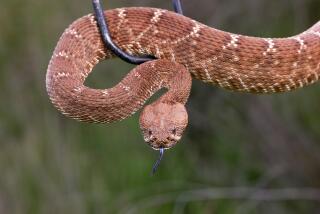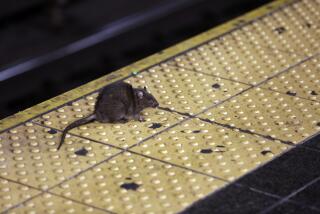Eastern Timber Rattler Creates Turmoil
WESTPORT, N.Y. — The ponytailed environmentalist hiked down the ridge, over the gray rocks and matted brown leaves, stopped among the hardwoods, and said, “Right down the side, it’s prime country here.”
The warm, southeast-facing rock cliffs overlooking Lake Champlain mark the northern limit of the eastern timber rattlesnake’s habitat. Jaime Ethier, in boots and jeans, was bushwhacking from Champlain Palisades down to the pebbled shores of the lake -- through terrain where he wouldn’t see a coiled dark snake unless he nearly stepped on it.
The Adirondack Council conservation director appeared unconcerned. He kept going off the trail to peer into crevices likely to hold a den of poisonous reptiles, whose spiky tails make the telltale rattle or buzzing sound when disturbed. He’d met a rattlesnake almost two years earlier in this forest 110 miles north of Albany and wanted to see another.
Ethier was out of luck on a day of overcast skies and temperatures in the mid-50s, probably still too cool for the snakes.
Ethier’s group wants to undo state conservation plans to allow mountain bikes in this neck of the 6-million-acre Adirondack Park, afraid cyclists will kill rattlers. Protected by state law, rattlers are a threatened species in New York, where bounties that led to their widespread killing were outlawed in 1971.
State wildlife officials estimate New York has 3,000 to 6,000 rattlesnakes left, mostly around the Hudson Highlands and a dozen Adirondack dens.
But the U.S. Fish & Wildlife Service has declined to list them under the federal Endangered Species Act.
“There are so few statewide, we feel that losing one or two to a mountain bike would be a tragedy,” said John Sheehan, the council’s spokesman. With more than 1,000 miles of trails and primitive roads already open to mountain bikes in the park, the group sees no need to add “recreational conflicts” to the rattlesnake’s diminishing range.
Cyclists counter that riding on 5 miles of trails in the Split Rock Mountain Wild Forest will do little harm.
“It’s a low probability that a biker’s going to run a snake over,” said Paul Capone, trail coordinator for the Adirondack Park Mountain Biking Initiative. “I’m sure there are rattlesnakes in that area, but for the most part I would say they prefer the habitat on the rocky open areas where bikes will not be riding.”
Bikes are allowed in 1.3 million acres of Adirondack wild forest and excluded from 1 million acres of more primitive wilderness areas. But as state officials issue new forest conservation plans, cyclists are losing ground. At Split Rock Mountain, they’re being kept off trails down to the shoreline.
“The reason people like to go there is access to Lake Champlain,” Capone said. “It’s kind of a critical time for mountain biking.”
Wildlife biologists say it’s also a critical time for eastern timber rattlesnakes, whose bite is seldom fatal to humans (they don’t always inject venom). Fear, misunderstanding, development sprawl and their attraction as dead curios or live pets have shrunk numbers, habitat and prospects.
Timber rattlers are found in rugged terrain and hardwood forests from east Texas to southern Wisconsin, and from north Florida to a spot in New Hampshire. Believed gone entirely from Maine and Rhode Island, they are considered threatened or endangered in the Northeast except Pennsylvania, which has licensed hunting.
Rattlers hibernate in winter and are active from about May through September. Females start reproducing at age 8 or 9, giving birth to litters of five to 12 every few years. They mate in late August.
“Given their low reproductive rate along with a high mortality rate of young, as well as being killed or captured by humans, the timber rattlesnake is in serious trouble in the Northeast,” James Beemer, a civilian Defense Department biologist, wrote in a 2001 study.
With no reports of snake-cyclist incidents in the Tongue Mountain Range above Lake George, where mountain biking is allowed, the state Department of Environmental Conservation says it expects none above Lake Champlain but will monitor it.
Rattlers have not been responsible for any fatalities in New York for decades.
Unless you try to pick up or harass one, you stand a better chance of being struck by lightning than bitten, Beemer said.
After studying timber rattlers for more than a decade, he notes that the ambush hunters are deadly to mice, chipmunks and squirrels but are “extremely shy” of humans and will hide or try to leave unnoticed.
More to Read
Sign up for Essential California
The most important California stories and recommendations in your inbox every morning.
You may occasionally receive promotional content from the Los Angeles Times.









